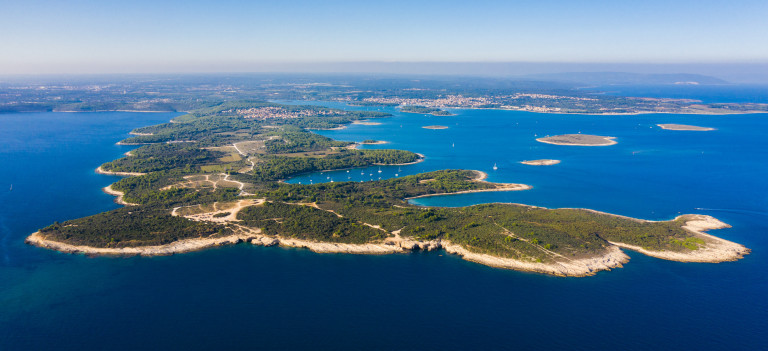
Premantura
Located at the end of the peninsula, immersed in the blue-green sea, it creates a magnificent scene. 30 kilometers of coastline, coves and beaches, uninhabited islands, unique flora, and breathtaking scenery make Premantura a unique place. Its sea is one of the cleanest in the Mediterranean. The typical Mediterranean architecture gives the impression of a sleepy seaside town that resists the sea winds. In the center is the tower of the church of Saint Lovra, the patron saint of Premantura, which is visible from the sea and has served as a landmark for fishermen and sailors for years. Its history goes deep into the past. The early presence of life on the peninsula is evidenced by 70-million-year-old dinosaur tracks on the nearby island of Fenoliga and the remains of old buildings several thousand years old.

Due to its location, natural resources, and openness of its inhabitants, Premantura is the perfect destination for those who want an active holiday in a unique environment. Cape Kamenjak, 9.5 km long, a protected landscape, is known for its stunning 30 km long coastline (with large and small intimate coves and exceptionally clear sea) and for more than 570 plant species, 30 of which are on the endangered species list. . Among them are 20 species of orchids, some of which are endemic. In front of Cape Kamenjak rises Porer, a lighthouse built in 1833 on an 80 m wide rock, where today those who want a peaceful and unique Robinson holiday can be found. Premantura, with its exceptionally clean sea and the winds that kiss its coast, is a paradise for windsurfers, and its undersea rich in fish, shallows, underwater rocks, and sunken ships tempts every diver. Nowhere else does the sunset have such beauty, even on a bright night when the river of the moon spreads with passion. Premantura offers an unforgettable escape that nourishes the senses, energizes the body, and awakens the spirit.
The dinosaur tracks, found on the island of Fenoliga in 1975, probably belonged to theropods, ornithopods, and a type of sauropod dinosaur, dating back to the Cretaceous period, between 65 and 70 million years ago. In ancient times, Premantura was known as Capo di Pola, and then in the 1st century, the Roman Pomponio Mela named it Promunturium Polaticum, which is where its current name comes from. According to the findings, Premantura was inhabited 4000 years ago. Three ruins were found where life continued even after the Roman occupation when it spread along the coast. From that period, along with some buildings, monuments with Greek and Latin inscriptions and a bronze statue of Minerva were found. During the Roman Empire, together with Pomer, Premantura belonged to Pula, and in the 5th century, it came into the possession of the Vesco family, and then in the 8th century under the possession of the Sergi family. It came under Venetian rule in 1331. In 1585, the first settlers from Dalmatia, more precisely from Zadar, came to Premantur, driven out by the Turks. The Church of St. Lorenca was built from 1632 to 1664. It is assumed that it was built on the foundations of the church of St. Nicholas in the middle of the 15th century. Nearby is a valley called Runtian or Runtianum. On the site of this village in the Middle Ages, the settlement of Ronzano, later Ronzi, and today it is called Runke, was established. After the robbery, it was destroyed by the Uskoks in the 17th century, as well as the church dedicated to St. Martin in the bay. Several other military facilities exist from the Austro-Hungarian period.
RECOMMENDATIONS:
Parish Church of St. Lovre - built in 1632, with 5 altars and a bell tower 27 m high.
Fenoliga - an islet in front of Premantura, with many fossilized footprints of two-legged carnivorous dinosaurs - theropods and ornithopods, as well as fingerprints and oval-shaped four-legged sauropod dinosaurs.
The Porer lighthouse - located on the same island, was built in 1833 and has a 35 m high tower; it is located 2.5 kilometers from the mainland
The protected landscape of Cape Kamenjak, 9.5 km long and 400 to 1600 meters wide, immersed in the blue-green sea, is home to more than 570 plant species, 30 of which are protected, especially numerous species of orchids from 33 families. White dusty interlaced roads lead to its beautiful coast, over 30 km long, with alternating rocky and sandy beaches. The islets near Kamenjak are a place where you can still see cows grazing
Windsurfing - due to the favorable winds and specific coast, this place is ideal for windsurfing
Diving - Premantura's seabed is ideal for diving due to its crystal clear sea, shallows, reefs, and submarines, of which we recommend the torpedo boat Flamingo of the Austrian Navy, which ran into its mine during the First World War and today lies at a depth of 45 meters
Fishing - the area of Premantura is extremely rich in fish. This region contains almost 90% of all fish species that live in the Adriatic. It is not uncommon to see dolphins swimming, and catching fish with local fishermen.








